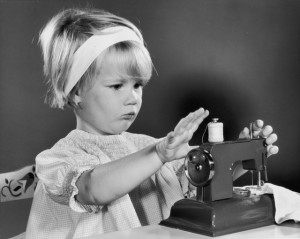To arrange for a service or repair, please complete this form & I’ll get back to you ASAP.
Is your sewing machine misbehaving? Have an old one you want to get working again? I can help with that! My objective is to get your machine back to you as soon as possible, for a reasonable price. These are some of the most common Frequently Asked Questions (FAQ).
(Click on the cross on the left to see the answers)
I don’t have a car. How can I get my machine to you or returned?
I do house calls! If you live within 25 miles of Hamburg, NY, I can do a house call at no additional charge. It might be necessary for me to take the machine with me, if more specialized care is needed. If you are more than 25 miles from Hamburg, mileage will be charged at IRS rate of $.65/mile, each way.
What is an Inspection/Diagnosis session?
An Inspection/Diagnosis session is where I would simply run the machine in all configurations for which it is designed and determine its functionality. I would also remove all covers to expose the inner components and inspect for damage or any other signs that the machine may not function properly. An Inspection/Diagnosis session does not involve any cleaning, oiling, or adjustments as you would find with a tune-up. After completing this session, I would call or email you to discuss what was found and see how to proceed.
An Inspection/Diagnosis session could be useful if you need a professional to check out a machine you’ve recently purchased from an antique shop, the classifieds, an on-line auction, or maybe found, inherited or brought out of the attic. It can be helpful if the condition is unknown, and you’re not sure if you are ready to invest in a tune-up or any other repairs. Alternatively, you may have a machine that is not working well and has a problem that you can’t solve.
I will gladly inspect any machine that is brought to me. There is a non-refundable fee of $35 inspection/diagnosis, to be paid at the time the machine is received. This amount is credited against any other repairs or tune-up if you later decide you want more services performed.
Why is there a charge for an Inspection/Diagnosis session?
While I would not be doing any cleaning or adjustments as I would with a tune-up, it still takes time to disassemble and inspect your machine, along with reassembly. There needs to be compensation for this time.
Some machines may need repairs, and I will assess what repairs may be needed and the estimated cost. Most machines will just need a basic tune-up if nothing is broken or missing. I will advise if I think it would be unwise to invest further if repair costs would exceed the value of the machine.
How do I know if my machine needs a tune-up?
Your machine could need a tune-up if you can answer yes to any of these questions:
- Is your sewing machine skipping stitches?
- Is your sewing machine running too slowly?
- Does your sewing machine have loose stitches?
- Is your sewing machine making a grinding noise?
- Is the bobbin not winding correctly?
- Is your sewing machine gathering threads underneath the material?
- Does your sewing machine squeak & require oiling?
- Has it been more than 1 year since your sewing machine has been serviced?
What is included in a Tune-Up?
A Tune-Up is a Full Service that includes the following steps:
- Clean, Oil and Lubricate
- De-lint inside and clean outside of machine
- Oil all applicable parts
- Lubricate all necessary gears and pulleys
- Remove and clean tension assembly
- Check Electrical
- Check light bulb
- Check power cords and wiring for wear
- Check motor and motor belt operation
- Check Sewing and Feeding Mechanisms
- Check and adjust needle bar and hook timing
- Check and adjust zig-zag movement
- Check and adjust feed dog and stitch length
- Check and adjust stitch width
- Check and adjust bobbin case clearances
- Check thread path for obstructions
- Check for burrs, pressure foot damage or needle plate damage
- Sewing Test
- Check bobbin winder
- Check and adjust top tension
- Check and adjust bobbin tension
- Stitch test sew-out
What is the difference between Mechanical, Computerized & Electronic sewing machines?
There are 3 styles of machines: mechanical, computerized and electronic.
The best way to describe mechanical sewing machines is to say they have ‘all the basics’. Knobs and dials are used to change the settings on the machine which make for a bit less precise stitch than its electronic and computerized counterparts. ‘Higher end’ mechanical machines may have several decorative or utility stitches. Mechanical sewing machines are often the most affordable.
Computerized machines will be the most expensive style. These machines not only do a variety of utility and decorative stitches, but have the capability of creating embroidery designs. Some machines will only accept cards with designs loaded on them, while others can be linked directly to your computer.
Electronic sewing machines are a ‘hybrid’ between mechanical and computerized other styles. These machines offer a larger variety of utility and decorative stitches, several styles of buttonholes, and very possibly an alphabet, but will not allow you to do embroidery. Electronic machines will typically have an LCD screen that allows you to make adjustment to your stitches – giving more precision in your sewing.
How much will this cost?
Prices as of 1 January 2025
- General Inspection/Diagnosis – $35 (paid at the time of drop off)
- Tune-Up or first hour of repair
- Straight stitch ONLY mechanical machines – $75*
- Mechanical or Electronic sewing machines – $85*
- Computerized sewing machines – $95*
- Longarm machines – $150*
- Each additional hour on any machine – $85 per hour
- Rush Service – $100
- Outside of 25 miles from Hamburg, NY – $.65/mile, each way
*Repair prices do not include the cost of any parts.
What is the difference between Mechanical, Computerized & Electronic sewing machines?
There are 3 styles of machines: mechanical, computerized and electronic.
The best way to describe mechanical sewing machines is to say they have ‘all the basics’. Knobs and dials are used to change the settings on the machine which make for a bit less precise stitch than its electronic and computerized counterparts. ‘Higher end’ mechanical machines may have several decorative or utility stitches. Mechanical sewing machines are often the most affordable.
Computerized machines will be the most expensive style. These machines not only do a variety of utility and decorative stitches, but have the capability of creating embroidery designs. Some machines will only accept cards with designs loaded on them, while others can be linked directly to your computer.
Electronic sewing machines are a ‘hybrid’ between mechanical and computerized other styles. These machines offer a larger variety of utility and decorative stitches, several styles of buttonholes, and very possibly an alphabet, but will not allow you to do embroidery. Electronic machines will typically have an LCD screen that allows you to make adjustment to your stitches – giving more precision in your sewing.
How long will it take?
House calls usually take at least an hour, sometimes longer. If needed, I might have to take the machine to my house for more specialized treatment. If I do the repairs at my home, the average turn-around time is normally 10-14 days for a tune-up. If there is any delay, I will let you know immediately. As soon as your machine is finished, I’ll get in touch to arrange pickup or drop-off. Repairs can take some time depending on the availability of parts and complexity of repair. If you require a rush service, there is an additional charge of $100.
What should I bring with my machine?
When you bring your machine, please also bring the power cord, foot control, bobbins, and any feet that came with the machine. If there is another attachment that is causing a problem, please include it as well.


